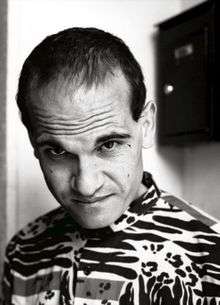Frédéric Bourdin
| Frédéric Bourdin | |
|---|---|
 Bourdin in 2008 | |
| Born |
13 June 1974 Nanterre, Hauts-de-Seine, France |
| Residence | Le Mans, France |
| Occupation | Serial impostor (1990-2007) |
| Spouse(s) | Isabelle (m. 2007) |
| Children | 4 |
Frédéric Pierre Bourdin[1] (born 13 June 1974)[2] is a French serial impostor the press has nicknamed "The Chameleon".[3] He began his impersonations as a child and claims to have assumed at least 500 false identities,[4] three of which have been actual teenage missing persons.[3][5]
Early life
Bourdin was born in Nanterre and raised by his grandparents in Nantes until he ran away and eventually went to Paris. He never knew his father, whom his mother stated was a married Algerian immigrant named Kaci.[6]
Impersonations
Nicholas Barclay, aged 13 at the time, was playing basketball with his friends in his home town of San Antonio, Texas, on 13 June 1994. Barclay never made it home and has not been seen or heard from since. In 1997 Bourdin took Barclay's identity and was flown to the United States. Although Bourdin had brown eyes and a French accent, he convinced the family he was their blue-eyed son, saying he had escaped from a child prostitution ring and the ring had altered his eye color.[6] Bourdin lived with the family for almost five months until 6 March 1998.
In late 1997 a local private investigator grew suspicious while he was working with a TV crew that had been filming the family. The investigator compared a photo of Bourdin's ears to Nicholas' ears and discovered that they did not match. In February 1998 the FBI obtained a court order to take the young man's fingerprints and DNA, which were later identified as belonging to Bourdin. In September 1998 Bourdin pleaded guilty to passport fraud and perjury in a San Antonio federal court. He was imprisoned for six years, more than twice as long as recommended by the sentencing guidelines.[1]
When Bourdin returned to France from the U.S. in 2003, he moved to Grenoble and assumed the identity of Léo Balley, a 14-year-old French boy who had been missing since 1996; DNA testing proved he was not Balley.[6]
In August 2004 he was in Spain, claiming to be an adolescent named Ruben Sanchez Espinoza whose mother had been killed in the Madrid bomb attacks. When the police found out the truth, they deported him to France.[3]
In June 2005 Bourdin passed himself off as Francisco Hernandes-Fernandez, a 15-year-old Spanish orphan, and spent a month in the College Jean Monnet in Pau, France. He claimed that his parents had been killed in a car accident. He dressed as a teenager, adopted a proper walking style, covered his receding hairline with a baseball cap and used depilatory face creams. On 12 June a teacher unmasked him after seeing a television program about his exploits. On 16 September he was sentenced to four months in prison for possessing and using the previous false identity of Léo Balley.[6]
According to interviews, Bourdin has been looking for "love and affection" and attention he never received as a child. He has pretended to be an orphan several times.[3]
Personal life
On 8 August 2007, Bourdin married a French woman named Isabelle after a year-long courtship.[6] The couple resides in Le Mans with their four children.[7]
According to The Daily Mirror, Bourdin claimed that he would "never impersonate anyone again".[8] Bourdin was interviewed in 2008 by David Grann, a columnist for The New Yorker. After Isabelle gave birth to their first child, Bourdin contacted Grann and told him that the child was a girl. Grann then asked if Bourdin had become a new person now that he was a father and a husband, to which Bourdin replied, "No, this is who I am."[1]
Depictions in the media
In 2010, a fictionalized account of the Nicholas Barclay case was brought to theaters under the title The Chameleon, by French director and screenwriter Jean-Paul Salomé. Bourdin – renamed Fortin in the film – was portrayed by Canadian actor Marc-André Grondin. The film was adapted from Le Caméléon, Christophe D'Antonio's authorized biography of Bourdin.[9] It premiered at the 2010 Tribeca Film Festival.[10]
The Imposter, a documentary about Bourdin's impersonation of Nicholas Barclay, premiered at the Sundance Film Festival in January 2012.[11]
References
- 1 2 3 David Grann (27 September 2008). "The great pretender: David Grann meets Frederic Bourdin, the man who pretended to be missing teenager". The Observer. Retrieved 4 August 2012.
- ↑ Mick Brown, "The Imposter: interview with the Chameleon," The Daily Telegraph, 11 August 2012.
- 1 2 3 4 Samuel, Henry (13 June 2005). "'Chameleon' caught pretending to be boy". The Daily Telegraph. Retrieved 13 July 2012.
- ↑ Laura Plitt, producer, "Frederic Bourdin – the man who changed his identity 500 times," BBC News, 19 October 2012.
- ↑ "France holds 'Chameleon' impostor". BBC. 13 June 2005. Retrieved 13 July 2012.
- 1 2 3 4 5 David Grann, "The Chameleon: The many lives of Frédéric Bourdin," The New Yorker, 11 August 2008.
- ↑ Gamelin, Carol (15 Jan 2014). "Frédéric Bourdin dit "Le Caméléon" a changé de peau". La République des Pyrénées. Retrieved 4 August 2014.
- ↑ Roper, Matt (30 June 2012). "The elaborate imposter: Conman, 30, fools family into thinking he is their missing teenage son". The Mirror. Retrieved 8 March 2013.
- ↑ Stephen Holden, "A 'Who Is It?' More Than a Whodunit," New York Times, 14 July 2011.
- ↑ Nathaniel Rogers, "Q&A: The Chameleon," tribecafilm.com, 24 April 2010.
- ↑ David Rooney, "The Imposter: Sundance Film Review," The Hollywood Reporter, 26 January 2012.